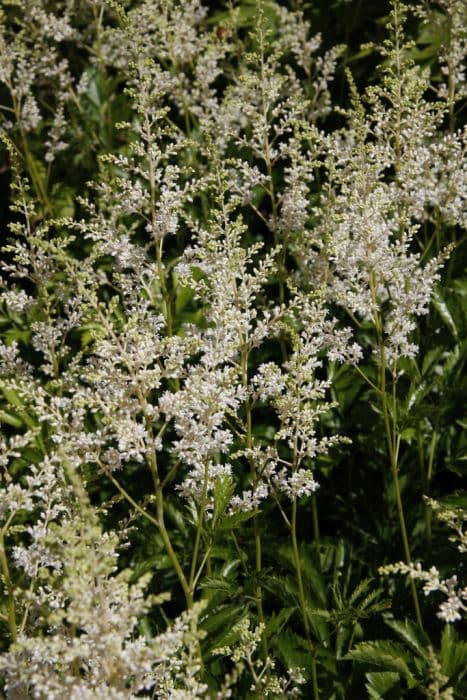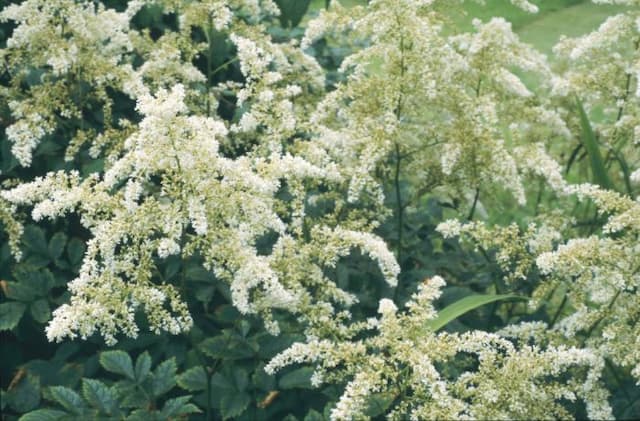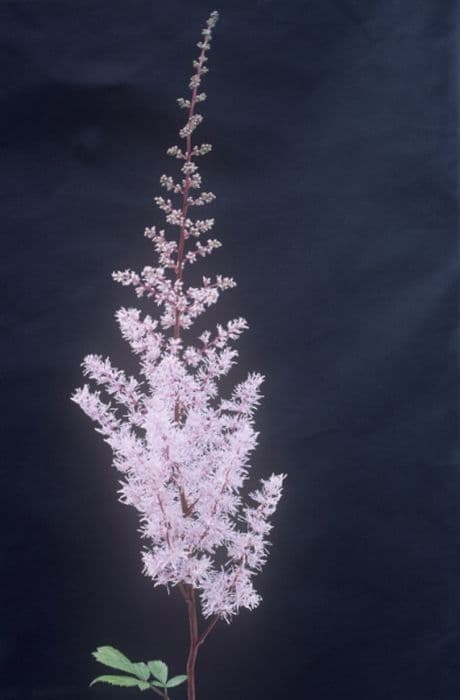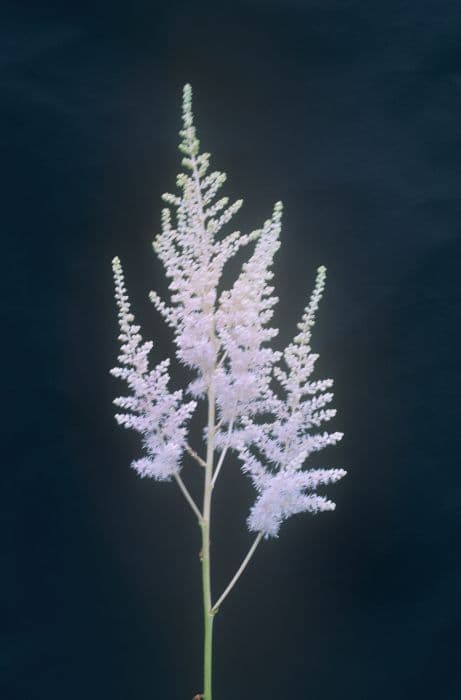False Spirea Astilbe 'Snowdrift' (× arendsii)

ABOUT
Astilbe 'Snowdrift' is a visually striking perennial plant known for its lush, fern-like foliage and its distinctive fluffy plumes of flowers. Its leaves are deep green with a glossy surface, finely divided into many smaller leaflets, creating a dense, feathery texture. This attractive foliage forms a bushy, mounding clump that provides an excellent backdrop for the flowers. The true showstoppers of 'Snowdrift' are its flower spikes, which are comprised of numerous tiny, closely-packed blooms. These flowers have a soft, pillowy appearance and are pure white in color, giving the impression of a snow-covered scene. The creamy white plumes rise elegantly above the foliage on slender, sturdy stems, creating a contrasting and eye-catching display. These blossoms have a gentle, airy quality to them and can add a light, ethereal feel to any garden space. Overall, Astilbe 'Snowdrift' has a delicate and graceful look, with its combination of fine-textured leaves and feathery white flower plumes. Its pristine appearance can brighten up shady garden areas and bring a sense of serenity to the landscape.
About this plant
 Names
NamesFamily
Saxifragaceae
Synonyms
False Goat's Beard, False Spirea
Common names
Astilbe × arendsii 'Snowdrift'.
 Toxicity
ToxicityTo humans
Astilbe is generally considered non-toxic to humans. Ingestion of this plant typically does not lead to any serious poisoning or adverse health effects. However, as with any plant, individual allergic reactions or sensitivities can occur, so it is always best to avoid ingesting plant parts if you're unsure about its edibility or your personal sensitivity.
To pets
Astilbe is also generally recognized as non-toxic to pets, including cats and dogs. It is not known to cause any significant symptoms of poisoning in pets if ingested. Nevertheless, pets may sometimes have a digestive upset if they consume a large amount of any non-food plant material, including Astilbe. If such symptoms occur or if the pet ingested a large amount, it is recommended to consult a veterinarian.
 Characteristics
CharacteristicsLife cycle
Perennials
Foliage type
Deciduous
Color of leaves
Green
Flower color
White
Height
2 feet (60 cm)
Spread
1 foot (30 cm)
Plant type
Herb
Hardiness zones
4
Native area
Asia
Benefits
 General Benefits
General Benefits- Attracts Pollinators: Astilbe 'Snowdrift' provides nectar and pollen for bees and other beneficial insects.
- Low Maintenance: It requires minimal upkeep once established, making it ideal for gardeners seeking a low-maintenance option.
- Shade Tolerant: Flourishes in partial to full shade, offering a brightening effect in darker garden spots.
- Drought Resistance: Once established, it can tolerate periods of dryness, although it prefers consistently moist soil.
- Adds Texture: The feathery plumes add unique texture and contrast to garden landscapes.
- Long Blooming: Provides a long season of interest with blooms that last for several weeks.
- Cut Flower: The blossoms are excellent for cutting and can be used in floral arrangements.
- Deer Resistant: Deer tend to avoid Astilbe 'Snowdrift', reducing the likelihood of damage from wildlife.
- Seasonal Interest: Offers visual interest throughout the year with its foliage and seed heads, even after flowers have faded.
- Variety of Uses: Can be used in borders, woodland gardens, and as an accent plant due to its versatile nature.
 Medical Properties
Medical PropertiesThis plant is not used for medical purposes.
 Air-purifying Qualities
Air-purifying QualitiesThis plant is not specifically known for air purifying qualities.
 Other Uses
Other Uses- Photography Prop: Astilbe makes an attractive addition to floral arrangements in photo shoots due to its feathery plumes and aesthetic texture.
- Fabric Dyeing: The flowers of Astilbe can be used to create natural dyes for fabrics, offering a range of soft, subtle colors.
- Artisan Crafts: Dried Astilbe flowers can be incorporated into handmade paper or used to embellish other craft projects for a touch of nature.
- Education and Science: Astilbe 'Snowdrift' can be a subject of botanical studies to teach about plant growth patterns, reproduction, and hybridization processes.
- Landscape Photography: Astilbe's delicate flowers can enhance outdoor photography, providing a serene and textured backdrop.
- Ice Cube Embellishment: The small flowers of Astilbe can be frozen into ice cubes to add an elegant touch to summer drinks and cocktails.
- Petals for Confetti: Instead of traditional confetti, the petals of the Astilbe flower can be tossed at celebrations like weddings for a biodegradable option.
- Table Decor: Fresh or dried Astilbe flowers can be arranged in small vases or as part of a centerpiece to create an inviting atmosphere for dining.
- Themed Gardens: Astilbe can be planted in "white gardens" where flowers of various species are all white, to create a monochromatic landscape design.
- Culinary Garnish: Although not a common practice, the flowers can be used as a non-toxic garnish for desserts and some culinary creations for visual enhancement.
Interesting Facts
 Feng Shui
Feng ShuiThe Astilbe is not used in Feng Shui practice.
 Zodiac Sign Compitability
Zodiac Sign CompitabilityThe Astilbe is not used in astrology practice.
 Plant Symbolism
Plant Symbolism- Patience: The Astilbe takes time to bloom and thus represents patience in waiting for the right moment.
- I'll Still Be Waiting: The name 'Astilbe' sounds like "I'll still be," which implies a message of waiting and loyalty.
- False Goat's Beard: Being also known as False Goat's Beard, it can symbolize a playful or whimsical nature due to its fluffy plumes that resemble a beard.
- Hope: The Astilbe is a hardy plant that can thrive in the shade, symbolizing hope and optimism in challenging conditions.
- Pride: With its lush, feathery blooms, the Astilbe is often associated with a sense of pride or dignity.
 Water
WaterFalse Spirea requires consistent moisture to thrive, so water it deeply once or twice a week, aiming for about one inch of water each time which would be approximately 0.623 gallons for a medium-sized plant. During hot and dry spells, you may need to water more frequently, while in cooler, rainy conditions, you can water less often. It's essential to keep the soil evenly moist without overwatering, as the plant does not like to be in waterlogged soil. Ensure the top couple of inches of soil are dry before watering again. A thorough soaking that reaches the roots is preferable to frequent light sprinklings.
 Light
LightFalse Spirea prefers partial to full shade, flourishing best in a location that receives filtered sunlight or morning sun followed by afternoon shade. Avoid exposing the plant to the harsh midday sun, especially in hotter climates, as this can scorch the foliage. The ideal spot would be under the canopy of taller trees or on the north side of buildings where it's protected from intense sun exposure.
 Temperature
TemperatureFalse Spirea thrives in cooler climates and is hardy in temperatures as low as -30°F to -20°F, making it suitable for many northern gardens. The plant performs best when daytime temperatures hover between 60°F and 80°F. It is important to protect the plant from extreme heat, as prolonged exposure to temperatures above 85°F can be detrimental to its health.
 Pruning
PruningPrune False Spirea after it has finished flowering to help maintain its shape and encourage a second bloom. Remove spent flowers along with any dead or damaged stems. Thinning out older stems can promote better air circulation and increase the plant's vitality. The best time for pruning these plants is late winter or early spring before they begin their new growth cycle.
 Cleaning
CleaningAs needed
 Soil
SoilFalse Spirea thrives best in a soil mix that is rich in organic matter and well-draining, with a pH ranging from 6.0 to 8.0. A blend of garden soil, compost, and peat with a layer of mulch to retain moisture is ideal.
 Repotting
RepottingFalse Spirea does not require frequent repotting and should be transplanted into a larger pot only when it has outgrown its current one, generally every 2-3 years.
 Humidity & Misting
Humidity & MistingFalse Spirea prefers high humidity levels, benefiting from a moist environment that simulates its natural habitat, although it can tolerate medium humidity as well.
 Suitable locations
Suitable locationsIndoor
Ensure moist soil, shaded light, and high humidity.
Outdoor
Plant in part shade, moist soil, and mulch well.
Hardiness zone
4-8 USDA
 Life cycle
Life cycleThe life cycle of Astilbe 'Snowdrift', commonly known as false spirea, begins with seed germination in the spring, provided the seeds have undergone a period of cold stratification to break dormancy. Next, the seedlings develop into young plants with characteristic finely cut foliage. As the plant matures, it develops a robust root system that includes rhizomes, which can give rise to new shoots. By mid to late summer, mature Astilbe 'Snowdrift' plants produce feathery plumes of creamy white flowers, attracting pollinators to the garden. Once flowering concludes, seed heads form and if not deadheaded, can self-seed under appropriate conditions. As a herbaceous perennial, the plant's foliage dies back in the fall, with the roots surviving the winter to regenerate the next spring.
 Propogation
PropogationPropogation time
Spring-Early Summer
The most popular method of propagating Astilbe 'Snowdrift' is by division, which is ideally done in the spring or late summer/early fall. To propagate by division, carefully dig up the entire clump of the plant, making sure to get as much of the root system as possible. The clump should then be gently pulled apart into smaller sections, ensuring that each section has at least one growing point or bud. These sections, or divisions, can then be planted into prepared soil, maintaining the same planting depth as the original plant. Water the newly planted divisions well to help establish their root systems. This simple, yet effective, method encourages healthy growth and allows for the expansion of Astilbe 'Snowdrift' in your garden space.









